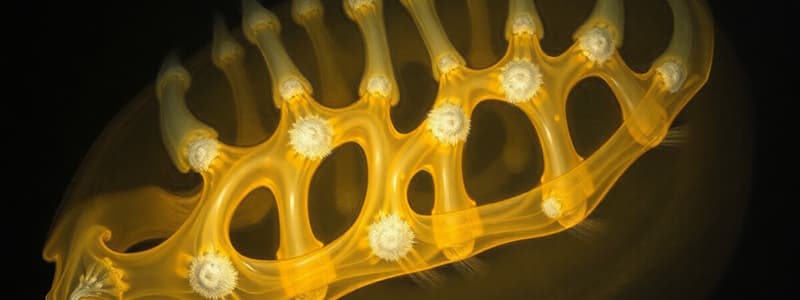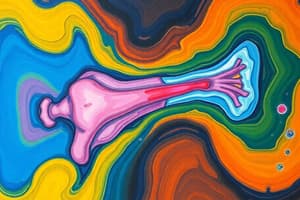Podcast
Questions and Answers
Most bones are born through ______ ossification.
Most bones are born through ______ ossification.
endochondral
The original support structure for endochondral ossification is a ______ cartilage model.
The original support structure for endochondral ossification is a ______ cartilage model.
hyaline
The process begins with chondrocytes near the center of the shaft becoming ______.
The process begins with chondrocytes near the center of the shaft becoming ______.
enlarged
As blood vessels penetrate the cartilage, ______ starts producing spongy bone at the primary ossification center.
As blood vessels penetrate the cartilage, ______ starts producing spongy bone at the primary ossification center.
Capillaries and osteoblasts migrate into the ______ to create secondary ossification centers.
Capillaries and osteoblasts migrate into the ______ to create secondary ossification centers.
________ hormone promotes osteoblast activity from the pituitary gland at the epiphyseal layers.
________ hormone promotes osteoblast activity from the pituitary gland at the epiphyseal layers.
________ stimulates cell metabolism and promotes osteoblast activity at the epiphyseal layer.
________ stimulates cell metabolism and promotes osteoblast activity at the epiphyseal layer.
Calcitriol, produced by the kidneys, is derived from vitamin ______.
Calcitriol, produced by the kidneys, is derived from vitamin ______.
An articulate cartilage remains exposed to the joint cavity; over time it will be reduced to a thin ______.
An articulate cartilage remains exposed to the joint cavity; over time it will be reduced to a thin ______.
Calcium and phosphate salts are needed to prevent ______ in children and osteomalacia in adults.
Calcium and phosphate salts are needed to prevent ______ in children and osteomalacia in adults.
At each metaphysis, an epiphyseal cartilage separates the epiphysis from the ______.
At each metaphysis, an epiphyseal cartilage separates the epiphysis from the ______.
Vitamin ______ is required for collagen synthesis and stimulates osteoblast differentiation.
Vitamin ______ is required for collagen synthesis and stimulates osteoblast differentiation.
Postnatal growth of bones involves chondrocytes in the epiphyseal plate continuing to divide and grow, adding length to the ______.
Postnatal growth of bones involves chondrocytes in the epiphyseal plate continuing to divide and grow, adding length to the ______.
Bone develops from hyaline cartilage, which becomes fully ______ after birth.
Bone develops from hyaline cartilage, which becomes fully ______ after birth.
Bone growth is under ______ control during development.
Bone growth is under ______ control during development.
Chondrocytes in the primary ossification site enlarge and stop secreting collagen and other ______.
Chondrocytes in the primary ossification site enlarge and stop secreting collagen and other ______.
Lateral bone growth is achieved by osteoblasts in the ______ laying down new bone.
Lateral bone growth is achieved by osteoblasts in the ______ laying down new bone.
Blood vessels grow into ______ transforming it into periosteum containing osteoprogenitor cells.
Blood vessels grow into ______ transforming it into periosteum containing osteoprogenitor cells.
Mature chondrocytes can not divide and die leaving ______.
Mature chondrocytes can not divide and die leaving ______.
Osteoblasts in ossification sites produce osteoid and turn into ______ as mineral deposits surround and harden around them.
Osteoblasts in ossification sites produce osteoid and turn into ______ as mineral deposits surround and harden around them.
Ridges in periosteum create a groove for ______ blood vessel.
Ridges in periosteum create a groove for ______ blood vessel.
Osteoblasts in endosteum build new concentric ______ inward toward the center of the tunnel.
Osteoblasts in endosteum build new concentric ______ inward toward the center of the tunnel.
Bone grows outwards as osteoblasts in periosteum build new circumferential ______.
Bone grows outwards as osteoblasts in periosteum build new circumferential ______.
Osteoblasts lay down bone while ______ break down bone on the inside of the medullary cavity.
Osteoblasts lay down bone while ______ break down bone on the inside of the medullary cavity.
At puberty, the cartilage in the epiphyseal plate is replaced with ______.
At puberty, the cartilage in the epiphyseal plate is replaced with ______.
Bone remodeling involves resorption of old bone and deposition of new bone where it is ______.
Bone remodeling involves resorption of old bone and deposition of new bone where it is ______.
Remodeling occurs in response to bone growth, blood ______ levels, and mechanical stress on the bone.
Remodeling occurs in response to bone growth, blood ______ levels, and mechanical stress on the bone.
Flashcards are hidden until you start studying
Study Notes
Endochondral Ossification
- Most bones are formed through endochondral ossification.
- Hyaline cartilage serves as the initial support structure.
- Osteoblasts replace dead chondrocytes (cartilage cells).
Steps of Endochondral Ossification
- Step 1: Chondrocytes in the center of the shaft enlarge, the matrix calcifies, and chondrocytes die, leaving cavities.
- Step 2: Blood vessels grow around the cartilage, and the perichondrium (cartilage covering) transforms into periosteum, forming a bone collar.
- Step 3: Blood vessels penetrate the cartilage, and osteoblasts lay down spongy bone at the primary ossification center.
- Step 4: Bone remodeling occurs, creating a marrow cavity. Osteoblasts continue adding bone at the ends of the cavity.
- Step 5: Capillaries and osteoblasts migrate into the epiphyses, creating secondary ossification centers.
- Step 6: Spongy bone fills the epiphyses, with articular cartilage remaining at the joint cavity, eventually thinning.
- Postnatal growth of bones:
- Chondrocytes in the epiphyseal plate divide and grow, lengthening the bone.
- Osteoblasts replace cartilage with bone.
- Bone growth is under hormonal control.
Appositional Growth
- Appositional growth refers to the increase in width or diameter of a bone.
- How it works:
- Ridges in the periosteum create a groove for a blood vessel.
- The ridges fuse, forming a tunnel lined by endosteum.
- Osteoblasts within the endosteum build new concentric lamellae inward.
- New circumferential lamellae are deposited by osteoblasts in the periosteum, leading to outward bone growth.
- The medullary cavity enlarges with increased diameter.
Bone Remodeling
- Bone remodeling occurs throughout life and involves the resorption of old bone and the deposition of new bone.
- Remodeling is influenced by:
- Bone growth
- Blood calcium levels
- Mechanical stress on the bone
Hormonal and Nutritional Requirements For Bone Growth
- Hormonal:
- Growth Hormone: From the pituitary gland, promotes osteoblast activity.
- Thyroid Hormone: Thyroxine, stimulates cell metabolism and promotes osteoblast activity.
- Calcitriol: Produced by kidneys from Vitamin D3, allows calcium and phosphate absorption from the digestive tract.
- Sex Hormones: Estrogen and testosterone, promote growth and accelerate osteoblast activity.
- Nutritional:
- Calcium and phosphate salts: Essential for bone health, preventing rickets (children) and osteomalacia (adults).
- Vitamin C: Required for collagen synthesis and osteoblast differentiation.
- Vitamin A: Stimulates osteoblast activity.
- Vitamin K and B12: Needed for protein synthesis, particularly for collagen.
Regulation of Bone Remodeling (Hormonal)
- Parathyroid Hormone (PTH): Released from the parathyroid glands in response to low blood calcium levels, stimulates osteoclast activity, increasing calcium absorption from the intestines and decreasing calcium excretion by the kidneys.
- Calcitonin: Released from the thyroid gland in response to high blood calcium levels, inhibits osteoclast activity and increases renal excretion of calcium.
- Both hormones work together to maintain calcium homeostasis.
Bone Remodeling: Response to Mechanical Stress
- Wolff's Law: Bones remodel in response to the forces placed on them.
- How it Works:
- Stress generates electrical currents within bones.
- Osteocytes are mechanosensors and secrete chemicals, influencing osteoblast and osteoclast activity, leading to bone thickening and increased density.
- Net Effect of Wolff's Law: Stressed bones become stronger, while unstressed bones become weaker.
Repair of Fractures
- Fractures are treated by realignment of the broken bone pieces (reduction) and immobilization.
- Open (compound) fracture: The broken bone protrudes through the skin.
Blood Supply to Bone
- The periosteum, endosteum, and bone tissue are richly supplied with blood vessels.
Nerve Supply
- The periosteum, endosteum, and bone tissue have a rich network of sensory nerve endings.
Studying That Suits You
Use AI to generate personalized quizzes and flashcards to suit your learning preferences.




